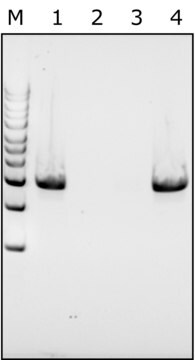M9901
Mutanolysin from Streptomyces globisporus ATCC 21553
lyophilized powder, ≥4000 units/mg protein (biuret), Chromatographically purified
Synonym(s):
Mutanolysin
Sign Into View Organizational & Contract Pricing
All Photos(2)
About This Item
Recommended Products
biological source
bacterial (Streptomyces globisporus)
Quality Level
form
lyophilized powder
specific activity
≥4000 units/mg protein (biuret)
mol wt
23 kDa
suitability
suitable for cell lysis
application(s)
diagnostic assay manufacturing
shipped in
wet ice
storage temp.
−20°C
Looking for similar products? Visit Product Comparison Guide
General description
Mutanolysin from Streptomyces globisporus consists of two main lytic enzymes and may be a useful agent for dental caries control.
Application
Mutanolysin has been used in a study to assess lysing and generating protoplasts of dairy streptococci. It has also been used in a study to investigate the conversion of group B streptococci to protoplasts. It provides gentle cell lysis for the isolation of easily degradable biomolecules and RNA from bacteria. It has been used in the formation of spheroplasts for isolation of DNA.
Provides gentle cell lysis for the isolation of easily degradable biomolecules and RNA from bacteria. It has been used in the formation of spheroplasts for isolation of DNA.
Biochem/physiol Actions
Mutanolysin is an N-acetylmuramidase. Like lysozyme, it is a muralytic enzyme that cleaves the β-N-acetylmuramyl-(1→4)-N-acetylglucosamine linkage of the bacterial cell wall polymer peptidoglycan-polysaccharide. Its carboxy terminal moieties are involved in the recognition and binding of unique cell wall polymers. Mutanolysin lyses Listeria and other Gram-positive bacteria such as Lactobacillus and Lactococcus.
Unit Definition
One unit will produce a ΔA600 of 0.01 per minute at pH 6.0 at 37 °C in a 1 mL volume using a suspension of Streptococcus faecalis cell wall as substrate.
Physical form
Lyophilized powder containing Ficoll® and sodium succinate buffer salts
Other Notes
View more information on enzymes for complex carbohydrate analysis at www.sigma-aldrich.com/enzymeexplorer
Legal Information
Fiberfrax is a registered trademark of Unifrax Corp.
substrate
Signal Word
Danger
Hazard Statements
Precautionary Statements
Hazard Classifications
Resp. Sens. 1
Storage Class Code
13 - Non Combustible Solids
WGK
WGK 1
Personal Protective Equipment
dust mask type N95 (US), Eyeshields, Gloves
Certificates of Analysis (COA)
Search for Certificates of Analysis (COA) by entering the products Lot/Batch Number. Lot and Batch Numbers can be found on a product’s label following the words ‘Lot’ or ‘Batch’.
Already Own This Product?
Find documentation for the products that you have recently purchased in the Document Library.
Customers Also Viewed
Pierre Godessart et al.
Nature microbiology, 6(1), 27-33 (2020-11-04)
Gram-negative bacteria are surrounded by a cell envelope that comprises an outer membrane (OM) and an inner membrane that, together, delimit the periplasmic space, which contains the peptidoglycan (PG) sacculus. Covalent anchoring of the OM to the PG is crucial
Amelia T Soderholm et al.
Frontiers in cellular and infection microbiology, 8, 160-160 (2018-06-06)
Streptococcus pyogenes (Group A Streptococcus; GAS) commonly causes pharyngitis in children and adults, with severe invasive disease and immune sequelae being an infrequent consequence. The ability of GAS to invade the host and establish infection likely involves subversion of host
Helena Žemličková et al.
Journal of medical microbiology, 67(7), 1003-1011 (2018-06-02)
Purpose. The aim of this study was to characterize serogroup 19 isolates resistant to macrolides and/or penicillin found among pneumococci recovered from cases of invasive and respiratory tract disease in the Czech Republic in 2014.Methods. Pneumococcal isolates of serotypes 19A
Mutanolysin for Improved Lysis and Rapid Protoplast Formation in Dairy Streptococci
Kondo, J. and L. McKay
Journal of Dairy Science, 65, 1428-1431 (1982)
David Greenwood et al.
Proteomics. Clinical applications, 14(3), e2000011-e2000011 (2020-03-31)
Periodontitis is linked to a localized dysbiotic microbial shift. This trending may often not be evident due to deep taxonomic changes of low abundance organisms and lack of consideration of variations in the treatment response. By using next generation sequencing
Our team of scientists has experience in all areas of research including Life Science, Material Science, Chemical Synthesis, Chromatography, Analytical and many others.
Contact Technical Service











